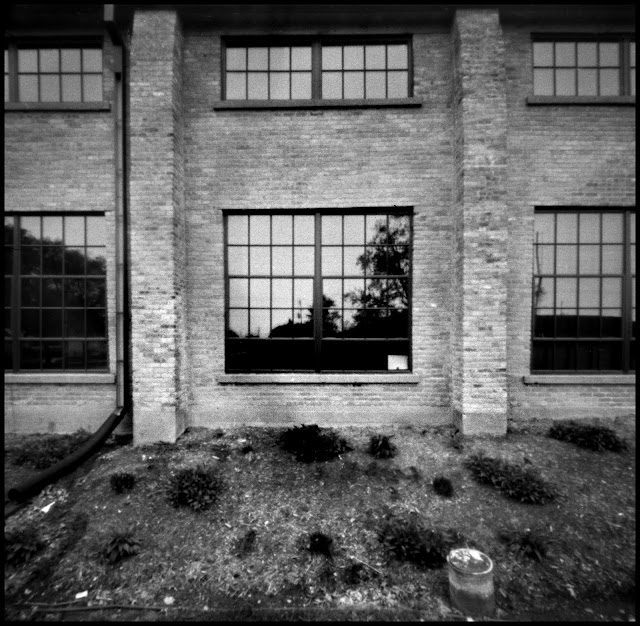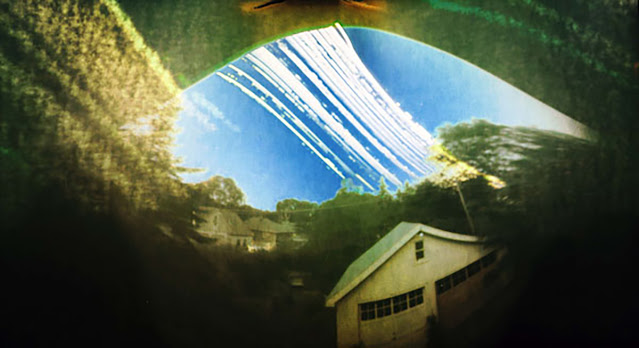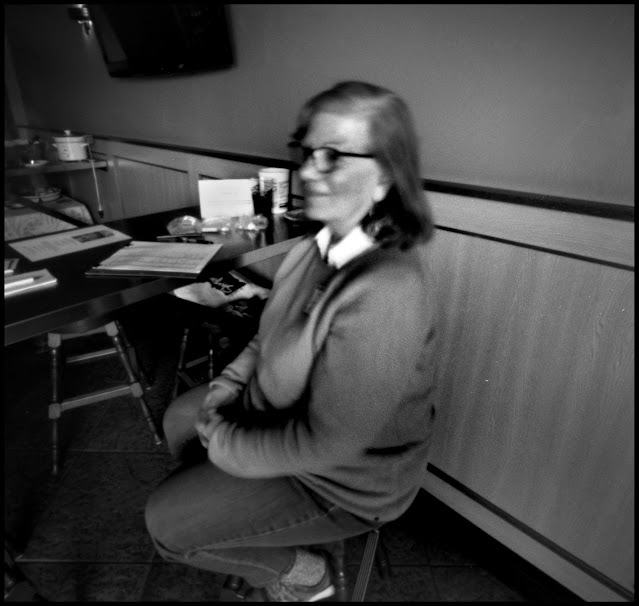Several things have gotten me thinking about Solargraphy lately.
First, in a backwards sort of way, I forgot to put out a camera for the recent lunar eclipse. The weather was iffy, and I couldn't open the shutter until after astronomical twilight about 9 pm. We got involved in a very dramatic series on Netflix and didn't think of it until mid-totality when we were ready to go to bed. Partly cloudy skies may have been interesting. At least I didn't have to go out at 4 am to close the shutter. That made me think of streaks across the sky.
I've also been collecting 14 ounce food cans with the tops removed with a can opener that splits the seam between the can and the top very neatly, which makes them easy and safe to make light tight. If I ended up with an empty half hour in the workshops that may occur this summer, we could make a couple quick solarcams.
In the same meeting of the Fox Valley Photography group where I expounded on "What Pinhole? Why Pinhole? and What, Me Pinhole?," Bobbi Hague gave a demo on building a classic pint beer can solargraph camera, which from some of her comments I think she learned from watching Justin Quinnel's video, which I had also watched most of recently.
Then I listened to the Lensless Podcast. The guest was Sam Cornwell, who makes and sells loaded-and-ready-to-put-out Solargraph cameras. Both Andrew and Corey were hosting. At least they didn't talk about cameras with lenses much. It was one-time-use 35mm cameras that came up. Actually, Sam is just completing a really impressive project with those cameras. I'd love to see the pictures.
Sam also brought up his current use of the Chroma Cube (again, 24x24x30 is not a cube.) The design and it's maker were much praised by everyone. Andrew concluded that segment saying that to him, using a 24x24mm camera would be "soul-destroying." I must not have one of those. I kind of enjoy the freedom and spontaneity of 35mm pinhole.
A discussion of Solargraphy finally came up. Andrew interrupted Sam's enthusiastic mission statement for everyone to experience this phenomenon. In case listeners might not know what Solargraphy was, he queried Sam for a description. I suppose I understood what he was talking about, but it seemed a little brief. He said that you really didn't need much understanding to experience it. (Did I just imagine someone said "and not have to figure it out for yourself"?). They did mention that the little book that Sam supplies with his cameras may be the best part. What really got to me was his conjecture that the people who had the most trouble understanding it were photographers, particularly wet photographers who couldn't imagine a world without development.
Haven't you ever left trimmings by the paper cutter in the darkroom and watched them turn dark and change color? Didn't leave a sheet out in the sun with a coin or some other object on it just to see what happened? I tried this with an 8x10 negative in a contact frame with Ilford Multigrade IIRC once. It got dark pink after about 4 days. Printing out papers were mainstays of contact printing proofs until the 1940's. I remember having WWII era boxes of surplus contact paper around. The idea that the direct action of the sun over long periods wouldn't affect paper isn't very alien, especially with an image formed by a lens or a pinhole. Any one familiar with exposure determination can see how much faster a direct image of the sun is than just reflected illumination. Talbot's first negatives were printing out materials. His exposures were hours long. I'm surprised he never accidentally got a solargraph streak in a window. He was acutely aware of where the light was coming from.
Well, instead of being a just grumpy old codger snarkily complaining about the lack of detail in the description of solargraphy, I'd like to explain how I understand it, and my limited experience with it.
The basic principle is that light bludgeons the silver halide crystals in the emulsion with such force and persistence that enough silver gets busted out of the crystaline grip of the halides that it forms grains, although much smaller and more distantly spaced than the grains many people complain about with developed 35mm negatives (oops, I said I wasn't going to do that).
The various colors of the image are a result of the size of these grains based on how much exposure they got. Different sizes of grains spaced differently inside the clear emulsion scatter different frequencies of light passing through it and reflecting off the white backing. It's exactly why the sky looks blue and why the infrared James Webb Telescope will see the center of our galaxy better, and radio telescopes even better. Talbot noted the varied colors in his negatives with different exposures and silver halide formulas.
Everybody comments on the sky being blue on a Solargraph scan with the color inverted. It just turns out that heavily exposed areas like the sky appear reddish on the negative, and if you invert that color you get blue.
My first experience of Solargraphy as an image making discipline was Tarja Trygg's
Solargraphy.com project in about 2005. She was mailing 35mm canister cameras loaded with a piece of paper all over the world and having them sent back. We probably corresponded by email based on a discussion in f295. I told her I could supply my own canister and paper and I would send
her the image and the data.
The film can was connected to the west-facing side of my house near the top. You can see the overhang of the roof. This sort of camera with a curved back is really wide angle. This is at least 180° horizontally. The exposure is from October 2005 until September 2006, almost from equinox to solstice and back again both ways.
We must have had some really cloudy periods in the fall and winter. It was fastened really solidly. Our garage, the neighbors garage, and the house behind them are rendered fairly well, although the wide angle makes them small. This was a .15mm Gilder Electron Microscope aperture. You can even see the telephone line stretching across the back yard. The sky is blue, the trees are green, but note that the garage roof, which has red shingles, is light green. What I don't understand is what are those cloudy looking streaks at the left that mirror the curve of the sun's path that continue into the overhang. Long term flare?
The next March, I put out a flat image plane Altoids tin and left it there 9 months. Looks like those cloudy bands in fall are a regular pattern. There's a dot at the right side of the garage. I think that's the bane of Solargraphers, a wet spot. Moisture tends to collect from condensation inside the camera and I think that's something alive.
I once put out two beer can cameras and the emulsion completely dissolved off the paper from moisture getting in through the pinhole.
The same time I put up that second camera, I also put one at the peak of the back of my garage. Getting the cameras off the house was easy because I had to go up to change the screens twice a year, but there's no reason to go up to the top of the garage until I had to paint it 20 months later. Regina Valkenborgh, who put one of these up in an observatory, just made headlines for longest exposure ever when it was found again after 8 years, so I'm not even close. Interesting that one streak of the sun is a different color.

I didn't try it again until 2017 when people were starting to submit solargraphs to the
Worldwide Pinhole Photography Day exhibit (as long as the shutter was open on Pinhole Day). In order to be a little different, I made a camera out of an Oaks Candy box which took a 4x8 inch sheet of paper with a makeshift septum dividing it into two chambers with a pinhole centered on each half. Unfortunately it turned out the sheet of paper got a little curved when I closed the box so the paths of the sun don't match. This is set up for crosseyed viewing. The 3D effect is there, but the sky gets a little confused.
Solargraphy has become wildly popular in one day workshops. It has a serious advantage. No wet darkroom. No darkroom at all. It's not exactly a discovery experience because participants have to take them home and expose them for at least a week, if not months. I've heard solstice to solstice mentioned as almost a standard.
I have several points of disinterest.
They usually use curved back cameras and I think it's hard to compete with the barrel distortion. They all look the same to me.
I have the same objection I have to any one day workshop experience. Cheap, easy and quick is good but it's limiting. Most of the exposures in these kind of workshops are a technical demonstration that you can get an image this way. No one is really working toward making a good photograph. It'll be pinholy! A lot of them end up looking exactly the same. I'm all for discovery but to lodge myself in codgerdom – Been there. Done that. Just using that phrase dates me pretty badly.
It's pretty common to display the entire negative like I've been doing. It's less interesting technically and meteorologically, but a cropped detail may be a little more interesting pictorially, which I very rarely see done. Here's less extreme wide angle of view from the middle of that 20 month negative. Kind of Gum-Bichromatey. Kind of reminds me of
Steichen's The Pond - Moonlight.
I have seen some creative work done. Seeing the solar track through a window or framing a significant architectural feature can make an interesting solargraph. My favorites recently were done by
Radek Rogalski in Poland, really
using the barrel distortion to entwine a foreground structure with the solar track, and
Chris Peregroy of Pinhole Blender fame where he bolted small figurines in front of a several cameras. Chris's exposure included Pinhole Day. I can't wait to see which one
he picks to submit.
I think I have saved enough cans for any wildly optimistic number of partipants in a workshop, so I should think of something to do with them. Maybe two stereo pairs at a baseline of a foot or two, one with a curved back and the other, a flat plane. They just cut down the tree that is so prominent in my stereo attempt above, so it would be a very different image, especially if I did it over the summer.
Part of the issue here is a bit of conflict between my arty photographer side and my pinholer and generally-inquisitive-person side. I'm probably going to be bored with the pictures, but I'm really curious to see what they look like.






























































